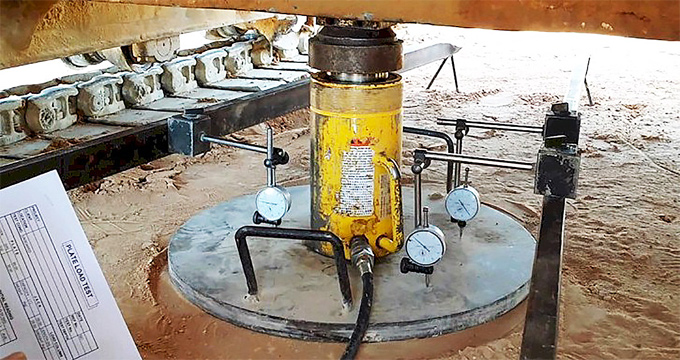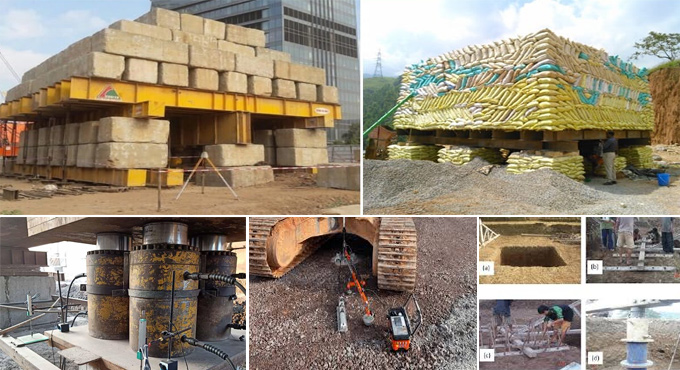
Plate Load Test: Know Procedure, Equipments & Methods

The plate load test helps to determine the soil’s load-bearing capacity as well as the actual strength of the soil. The plate load test has been performed in those cases where the size of the ground particles is large or the ground has a firmer texture. In the design and assessment of the working platforms, the plate load test has been applied, in which the ground properties have been determined. As a result, it has been ensured that the platform will be stable when in use. The plate load test should be performed correctly to meet all the safety criteria.

The plate load test can be carried out at the level of the foundation under a working platform. A circular steel plate has been positioned on the ground in this type of in-situ test and an increasing load has been applied until the plate starts to settle.
Equipment required for the Plate Bearing Test
Several equipment are crucial to perform the plate bearing test, which are as follows:
➢ A steel plate is required, which should be at least 300 mm square and 6 mm thick.
➢ A hydraulic jack is needed, along with a capacity of 1.5 times the anticipated test load.
➢ A pump is also required.
➢ A set of steel shims is also required, which should be at least 6 mm thick.
➢ Pressure gauge and dial gauge are needed, and the dial gauge should have a range of 0-250 mm and an accuracy of 0.02 mm.
➢ A reaction truss or reaction beam is also needed for the plate bearing test.
➢ A loading frame which has the capacity of 1.5 times the anticipated test load is required. In this context, the loading frame should be designed to attach to the ground, as a result, the load can be applied to the center of the plate.
➢ Equipment for the loading platform is also required.
➢ A tape measure or steel rule is also needed which should be at least 3 m long.
➢ Apart from the above equipment, numerous other equipment are also required, which include a plumb bob, a tripod, a spirit level, a set of wrenches, a hammer, and a clean and dry cloth.
Effectiveness of the Plate Load Test
There are several benefits of performing the plate load test to know the load-bearing capacity of the ground. These benefits are as follows:
➢ The conduct of the plate load test is relatively easy and quick.
➢ The plate load test can be performed on the construction site.
➢ A wide range of soil types can be tested through the plate load test.
➢ More accurate results can be achieved through performing the plate bearing test.
➢ The equipment for the plate load test is portable as well as easy to set up.
➢ The plate load test is also cost and time-efficient.
Methods used for the Plate Load Test
Generally, two methods are used for performing the plate load test, which are:
Reaction Truss Method
In this type of method, the hydraulic jack’s movement has been affected by the reaction truss. In this context, the soil anchors help to keep the truss in their right place on the soil. The soil anchors have been driven deep into the soil with the help of the hammers. The reaction truss has been constructed using mild steel sections. Ropes have also been used to keep the truss stable on the sides. This method is easy and quick to perform as well as less tedious.
Gravity Loading Platform Method
In this method, a working platform has been built on top of the vertical column, which rests on the test plate. In this method, stones, sandbags, or concrete blocks have been used to load the working platform. The test plate has settled upon the load application. The settlement has been ascertained with the help of the dial gauge. In this context, two dial gauges have been attached to a datum bar. After settling the plate, the ram of the dial gauges moves down. After that, on the hydraulic jack, the load has been measured from the load gauges.
Details about the Plate Load Test Procedure
The plate load test has been gone through several procedures, which are:
➢ A platform has been built over the column in the gravity loading method. In addition, sandbags have been placed for the load application.
➢ The hydraulic jack has been placed between the loading platform and column, as a result, the load has been applied gradually. These types of loading have been termed as the reaction loading.
➢ After that, three dial gauges have been set up on the working platform at the diagonal corners of the plate. This helps to measure the settlement of the plate.
➢ A seating load of 0.7 has been applied at the initial stage to compact the load.
➢ After that, loading has been applied at the rate of 0.25 mm/hour.
➢ The hydraulic jack is used to apply the load where the force increases slowly. The increment of the force is one-fifth of the expected safe bearing capacity or one-tenth of the ultimate bearing capacity.
➢ The pressure gauge helps to measure the load.
To learn more, watch the following video tutorial.
Video Source: Proud to be a Civil Engineer
➢ The settlement has been measured on the dial gauge upon the application of each increment of the load. The settlement should have to checked several times. This checking should be done after 1, 4, 10, 20, 40, and 60 minutes. This checking should be continued until the settlement rate is less than 0.02 mm per hour.
➢ After collecting all data for a certain load, the increment of the next load has been added, and the new reading has been taken under the new load.
➢ This procedure has been continued until the maximum load has been applied. In this context, the maximum load has been 1.5 times the expected ultimate load.


